Stargazing

|
The Andromeda Legend |

|
Let's go hunt for a galaxy... if it's a good, clear night you can see this
one just by looking -- which makes it the farthest thing you can see with your
eyes, at 2 MILLION light years away.
- To find it we start with the Great Square of Pegasus. The Great Square
is formed by these four stars here {trace out Great Square} and Andromeda's
head is the Northeast (upper left hand) corner star. The rest of Andromeda
is then the figure formed by the two curved lines that radiate Northeast
away from that corner {trace out Andromeda}.
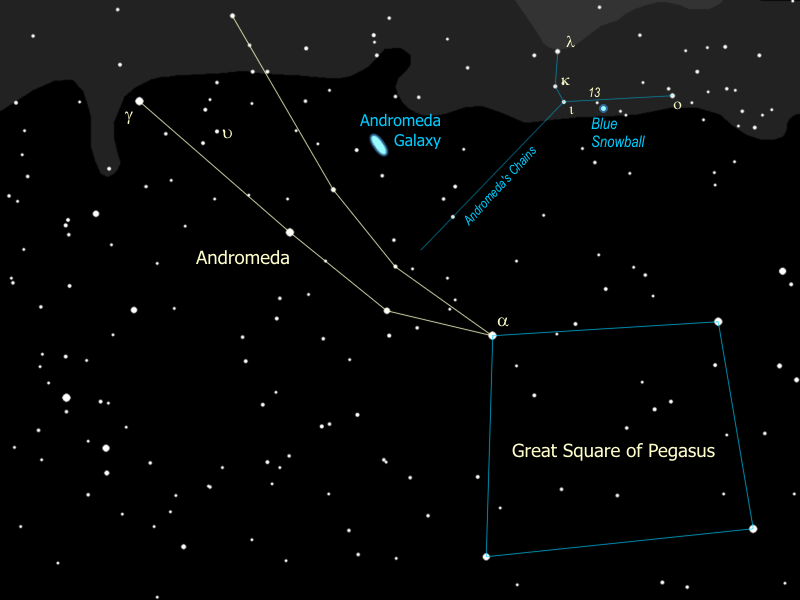
- Now let's find the Andromeda galaxy. Start with Andromeda's head, then
go to the next pair of stars, then to the next pair of stars after
that (a little further apart). Follow the line of that pair up and to the
right (Northwest) until you get to the next star. Look for a little fuzzy
patch just to the right of that star. It sometimes helps if you don't
look straight at it, but just off to one side a little bit. When you spot
it, just note that you are seeing far beyond our own galaxy, 2 million
light years away.
You need a good, dark sky to see the galaxy by eye, but it is easy to find in binoculars. In fact, it looks best in a good pair of binoculars, 10x50 or bigger. It is also an easy target for the telescope. If you look hard in the telescope you might see one or two smaller fuzzy patches near Andromeda. These are satellite galaxies, little galaxies orbiting the big one! Our galaxy, the Milky Way, has satellites of its own, called the Magellanic Clouds. They can be easily seen, looking like detached portions of the Milky Way, but they can be seen only in the Southern Hemisphere.
Andromeda in Telescope What you're looking at 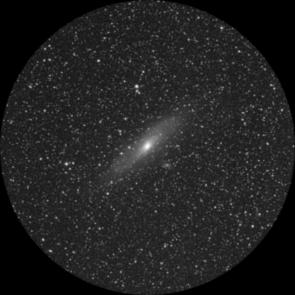
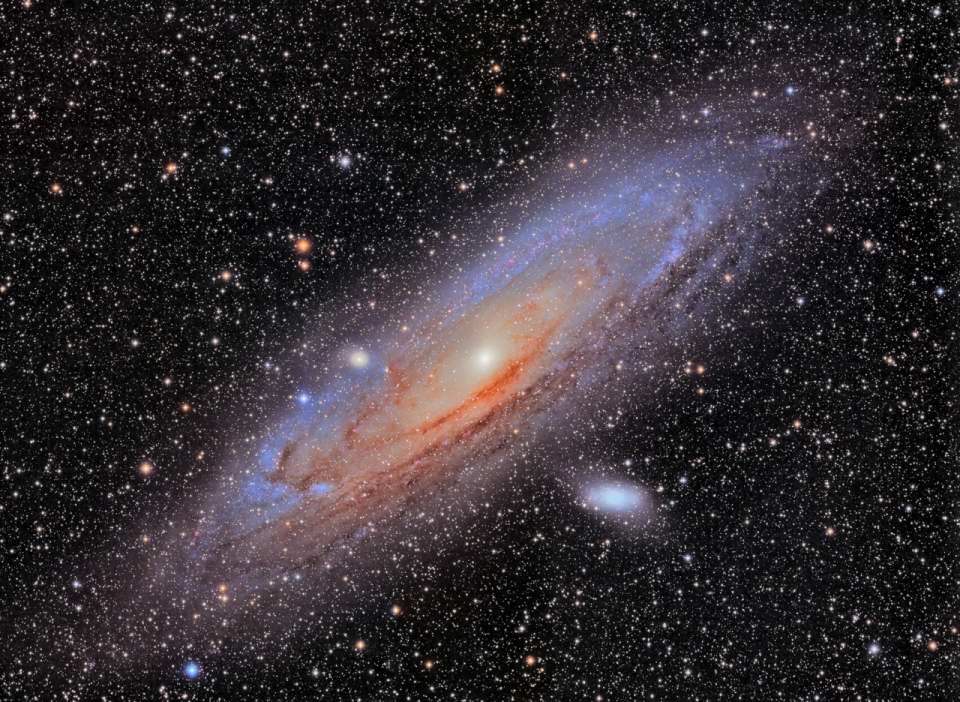
- We'll swing the telescope real quickly over to the star at Andromeda's
left foot (the Southeast one), γ (gamma)
Andromedae {point out γ Andromedae}. This is
a double star -- can you see the color difference between the two stars?
The bright one is yellow-orange, the other is a bluish-green. This is
one of the coolest looking doubles in the sky. It's a true double star
-- actually it's a four-star system, the blue one is really three stars,
but they're too close together for our telescope.
Another star of interest is &upsilon (upsilon) Andromedae, a star very similar to our own sun {point out υ Andromedae}. In 1999 three planets were shown to be orbiting ε Andromedae, making this the first system of planets to be discovered outside our own. (We can't see the planets in our telescope - they were found by calculation from the motion of the star).
- Andromeda is a princess and she is shown chained to a rock, by her daddy
the King. And it wasn't even for anything that she did, but we'll
get to that in a second. If you follow the chains up to the rock {formed
by λ, κ, ι, and ο Andromedae, point out the
rock} right next to that little bitty star right there {point out 13
Andromedae} is where we are going to focus the telescope. When you look
in the eyepiece you'll see two stars and something else... a puff of smoke,
maybe. Compare the little puff to the two stars next to it. Can you see
a color difference? The puff is actually blue, or blue-green. In fact
is known as the Blue Snowball. It's a star like the other two that you
see, but this star has blown itself apart!
Snowball in Telescope What you're looking at 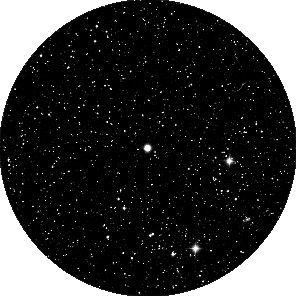
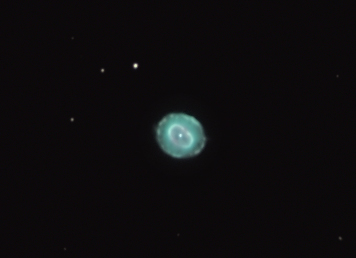
This is called a "planetary nebula", because the disk shape suggested the look of a planet to early astronomers. In fact it has nothing to do with planets at all. This is what's left of a red giant star that finally did what all red giants eventually do. When the fuel at the core runs so low that the nuclear reactions can no longer hold up the weight of the star, it all collapses in to the center, which in turn raises the temperature so high that the star blows off its outer envelope of gases, losing much of its mass. This exposes the core to outer space, or, more accurately, exposes outer space to the core. The intense radiation from the white-hot core causes the expanding shell of gas to light up like a neon light, and voila -- the faintly glowing disk that you see here. With a larger telescope you can still see the tiny star that remains at the center of the Blue Snowball -- now a white dwarf.
So a planetary nebula is completely different from a diffuse nebula like the one we saw in Orion. The Great Orion Nebula is the birthplace of many new, brightly shining stars. By contrast a planetary nebula is the deathbed of a single star, fading to a white dwarf. (Note that a planetary nebula is also subtly different from the Crab Nebula which is a supernova remnant -- much larger, much more violent, and with a neutron star at the center instead of a white dwarf). A few billion years from now, our sun will look a lot like the Blue Snowball.
- So how did Andromeda end up chained to a rock? It all started with her
mother, the Queen Cassiopeia. Does anyone know how to find Cassiopeia?
(Very often someone will). That's right, Cassiopeia is a Big W on the
opposite side of the North Star, Polaris, from the Big Dipper. We'll come
back to the Big Dipper in a little while. At this time of the year
Cassiopeia is upside down so now it's a big "M" instead of a big "W".
Notice that once you've found it, you can zero in on Polaris, as the center
peak of the "W" points in the general direction of the North Star.
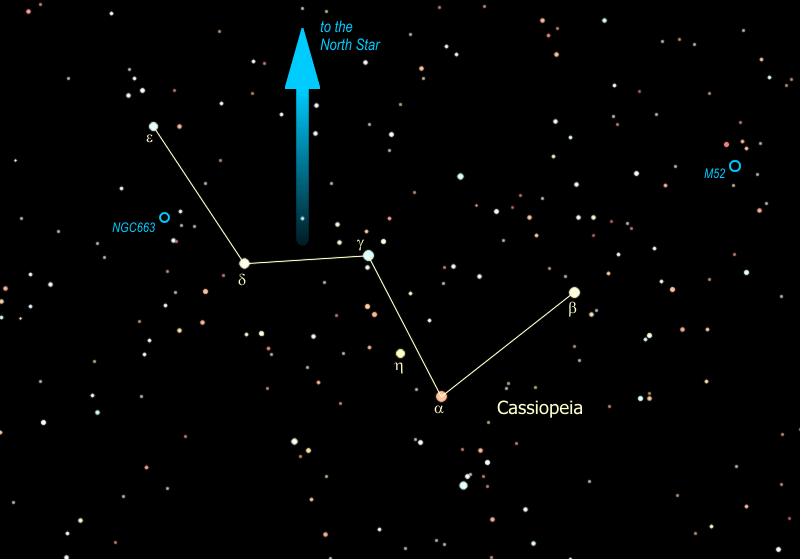
- The constellation Cassiopeia lies right smack in the middle of the
Milky Way, and is filled with open
clusters, like M52, a "young"cluster of about 200 stars -- young means
that it is only about 100 million years old. The cluster is 10 light
years in diameter and 3000 light years away from us, which is why you need
the binoculars to see it.
Another interesting galactic cluster is NGC 663 This cluster lies about half way between the two stars on the flattened side of the "W", ε and δ Cassiopeiae. As you sweep the binoculars between the two stars, you will notice that NGC 663 is merely the largest and brightest of several clusters in this region. That may be because it is the closest, at about 3000 light years. The others in that area are 6000 - 8000 light years away. How many clusters can you spot between these two stars? You might be able to see as many as five, with NGC 663 at the center and the other four marking the corners of a diamond around it.
M52 - Note the little box of stars around the cluster NGC 663 - halfway down the left side of the "W" 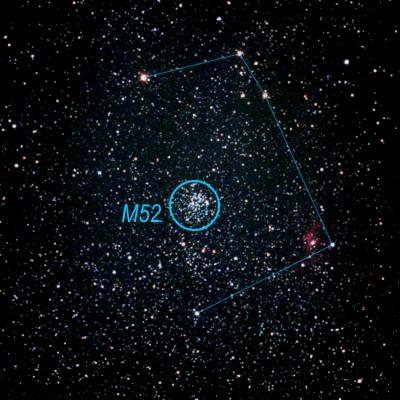
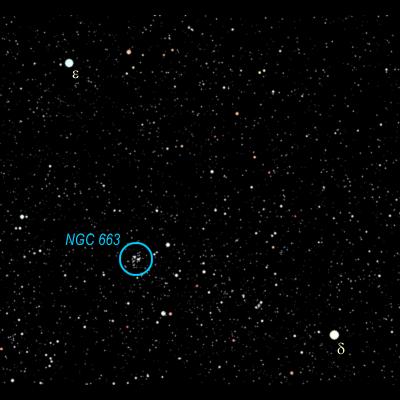
- So Cassiopeia had a reputation far and wide for her beauty, and that was
not enough for her. She started going around boasting that she was more
beautiful than the Nereids, the sea nymphs. When the Nereids caught wind
of this they complained to Poseidon, god of the sea, who sent a huge sea
monster, Cetus, to wreak havoc in the kingdom Godzilla-style. You can just
see Cetus on the western horizon at this time of the year {trace out the
head & body of Cetus} -- pretty terrifying, huh?
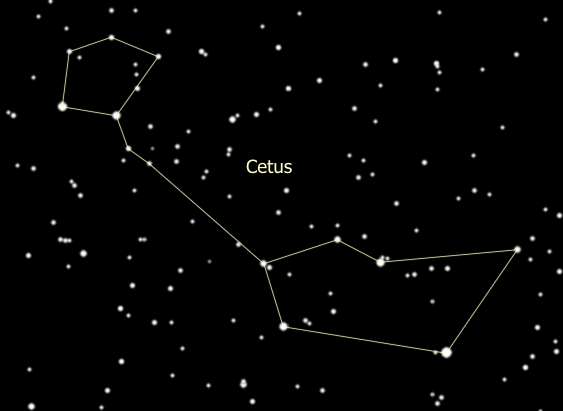
- All of which brings us to Cepheus the King -- Cassiopeia is his queen, and Andromeda is his beautiful daughter. Cepheus is a house-shaped constellation very close to the Northern horizon at this time of the year. {Trace out Cepheus}.
- This constellation contains the reddest star in the sky, μ(Mu)
Cephei, also called "The Garnet Star" and is located halfway
between the two stars at the bottom of the house. It is a red super-giant,
1,500 times the size of the sun. It was considered the largest star known
to man until just recently when 3 other stars (which you can't see without
a big telescope) were measured about the same size but just barely edge it
out. Placed where our sun is, the surface of μ
Cephei would extend out past Jupiter. If you are ever on an expedition to
the planet Mars, you might want to know that μ
Cephei is the pole star for Mars.
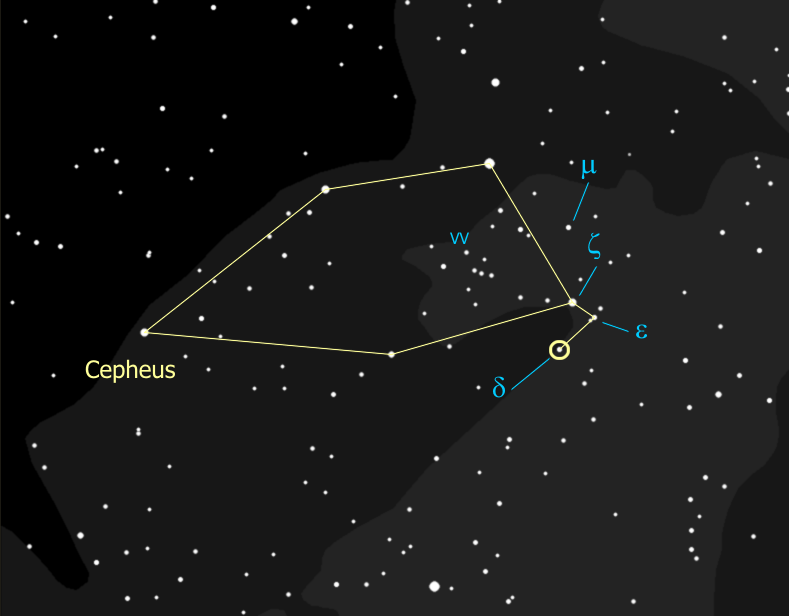
- Another star in Cepheus is of crucial importance to astronomy -- δ (Delta) Cephei. {Locate δ Cephei.} This star is a "variable", meaning the star's brightness varies over time -- in this case it varies between that of ζ (zeta) Cephei and ε (epsilon) Cephei over a period of five days. How bright is it now -- as bright as ζ, ε, or in between? We will assess again each night that we can during the week.
- This star was the first of its type to be discovered, hence these variable stars
are called 'Cepheid' stars. Cepheid stars have gotten to just the right mass to
be unstable - so the whole star is pulsating, the surface of the star is actually
rising and falling, with a rhythm that is so precise you could set your watch to
it. It was discovered in 1912 that this rhythm depends directly on the true
brightness of the star -- the brighter the star, the longer the time between
peaks. This discovery, as it happens, rocked the astronomy world. So why was
this such a big deal?
Well when a star is closer to us, it seems brighter. When it's farther away it seems dimmer, right? And we know the true brightness of a Cepheid star, from the cycle time of its brightness. If we know the true brightness of the star, and we measure its apparent brightness, we can figure out the distance to the star. If the star is part of a cluster or a galaxy, this tells us the distance to that entire body of stars. This has been used to find the distances to globular clusters, other galaxies and even our distance from the center of our own galaxy -- 28,000 light years.

In 1924, Edwin Hubble (yes, the telescope is named after him) used Cepheids to measure the distance to the Andromeda 'nebula' (2.3 million lightyears) and proved that it is not another solar system in formation but an 'island universe', another galaxy like our own. This was an extraordinary declaration about the structure of the universe back in 1924. Our whole system of measurement of the universe is built upon the Cepheids as our basic yardstick.
- Then on top of all that, if we look in the telescope we can see that bright
yellow δ Cephei has a beautiful blue companion -- so this is both a
variable star and a binary! The yellow star is the variable component, and
once was a blue star like its companion. It is now expanding out as it goes
through the end-of-life process, and is passing through an unstable phase as
it does so. The pair is about a thousand light-years from us, based on the
Cepheid period-brightness relationship.
Meanwhile, back in the kingdom, we left Cetus tearing things up, and Cepheus, as the local King, is presiding over this disaster. He consulted his oracle to determine what to do, and the oracle told him that the only way to appease the angry sea god was to sacrifice his daughter, that would be Andromeda, to the sea monster. Sadly, the king chained up his daughter to the rocks by the shore to await the arrival of Cetus.
So here we have them all -- Cepheus the King in a jam, Cassiopeia his beautiful if not terribly bright queen, Andromeda his lovely daughter chained to a rock, and here comes Cetus lumbering like Godzilla with devastation in his wake and our poor little princess in his sites! Are they all going to just sit there watching? Won't somebody DO something?
 |
 |
 |
| Back to Auriga | Go to Winter Index | On to Perseus the Hero |
Questions
Your questions and comments regarding the Stargazing section are welcome.
You can e-mail the author, Randy Culp for inquiries,
suggestions, new ideas or just to chat.
Updated 09 August 2020
